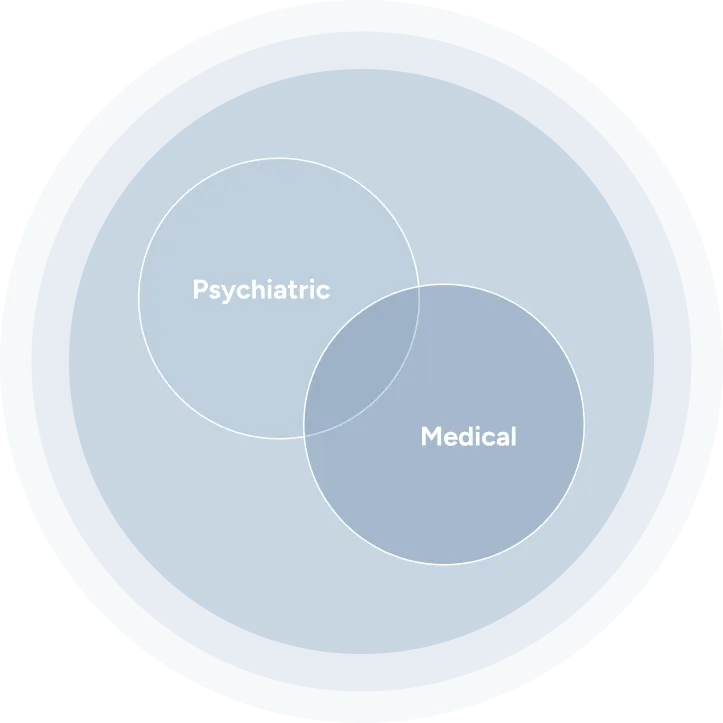Home / Inpatient Mental Health Treatment Program / Acute Stress Disorder
Acute Stress Disorder
Traumatic events wreak havoc on the mind, body, and spirit of the people who witness such events. For some people, the effects of trauma leave a more lasting mark on the psyche. In such cases, a condition known as acute stress disorder (ASD) may develop. Mental health professionals consider ASD to be a temporary condition. However, if symptoms continue, people dealing with acute stress disorder may undergo an additional assessment to determine whether they have post-traumatic stress disorder.
Why People Develop Acute Stress Disorder
Acute stress disorder develops when a person experiences or witnesses one or more traumatic events. These events often cause them a great deal of psychological, physical, or emotional harm.
Traumatic events fall into a couple of categories: serious injury, exposure to or the threat of death, and sexual violation. What that may more specifically look like for the client are incidents like the following:

- Sexual assault or rape
- The death of a loved one or the threat of death to themselves or a loved one
- Car accidents
- A serious accident that causes serious bodily injury
- Being diagnosed with a terminal illness
- Divorce or separation
- Domestic violence
- Terrorism or war
- Natural disasters, like fires, floods, hurricanes, and earthquakes
- Traumatic brain injury
- Mass shootings
- Facing a challenge that seems impossible to overcome
Mental health professionals originally developed the diagnosis of acute stress disorder to help them determine which individuals might go on to develop post-traumatic stress disorder. It is estimated that between 5% and 20% of people who encounter a traumatic event will go on to develop ASD. Another 50% or so of those who experience or witness a traumatic event will eventually develop PTSD as well.
While it isn’t completely understood why some people develop the condition and not others, there are a few helpful ideas to keep in mind. The human body has built-in mechanisms to deal with distress and will typically exhibit a stress response when a threat arises. This bodily response is automatic. Most people know of this condition as the fight, flight, or freeze response.
During traumatic events, a person will feel a surge in his or her heart rate. Elevated blood pressure levels, heightened metabolism, rapid breathing, sweating, and the tensing of muscles are all hallmarks of the body’s stress response.
After the immediate threat has subsided, the body may still have elevated response levels known as hypervigilance; this is to keep the body alert in case another threat shows itself. However, it can become a problem if it the state of hypervigilance persists. Continued elevated response levels can affect concentration and mood, making life after the traumatic incident more challenging to deal with.
ASD vs. PTSD
People who have been diagnosed with acute stress disorder often exhibit symptoms that are the same or similar to those who have been diagnosed with post-traumatic stress disorder. However, according to mental health professionals, unlike the person who receives a PTSD diagnosis, the individual diagnosed with ASD typically will experience symptoms only temporarily. That is to say, these individuals may experience signs anywhere for three to 30 days after the initial traumatic event takes place.
If the traumatized person continues to experience traumatic stress symptoms after the 30-day time period is over, he or she may require a new assessment. At that time, a doctor can determine whether the patient has post-traumatic stress disorder. Not everyone who experiences ASD develops PTSD, and some people who develop PTSD never feel ASD first.
That said, most people who experience acute stress disorder improve on their own with no special treatment required. Those who do require some treatment generally respond to psychotherapy and, occasionally, medication if the symptoms persist or become more severe.
Diagnosing acute stress disorder may take some time. The mental health professional must talk with the distressed person to learn more about the traumatic event itself and about the symptoms the person is exhibiting.
If, after speaking with the affected person, the mental health professional determines that the person is experiencing nine or more of the symptoms of ASD within a month of the event, then the distressed person will likely be diagnosed with ASD. If the symptoms persist past the one-month mark, then the mental health professional may consider assigning a PTSD diagnosis.
Finally, before the mental health professional can make a full assessment, he or she must rule out any other conditions. These include issues with substance misuse, other psychiatric disorders, and an underlying medical condition.
What Are the Symptoms of ASD?
This condition is marked by a number of symptoms that allow mental health professionals to make a determination for or against acute stress disorder. Again, these symptoms must be present for a period of three days and up to 30 days.
Understandably, traumatic incidences may set off feelings of extreme helplessness and terror in the person who experienced or witnessed the event. As such, both physical and psychological symptoms may develop.
Doctors and mental health professionals attribute the physical symptoms of the condition with a change in the person’s stress hormones.
Some physical symptoms that someone with ASD might exhibit include:
- Headaches
- Nausea
- Heart palpitations
- Chest and/or stomach pain
- Breathing difficulties
- Sweating
The onset of these symptoms usually comes very quickly. It isn’t unusual for a person to develop the above physical symptoms within hours or even minutes of the event. Many of the symptoms may become clearer in the days that follow. For some people, the physical symptoms of the trauma may continue for weeks.
As far as the psychological symptoms, there are a few that mental health professionals associate with acute stress disorder. These include:
- Negative mood: Generally speaking, the person experiences a low mood and may have challenges expressing or even feeling more positive emotions.
- Arousal: A state of hyper-arousal or hypervigilance can develop, which can cause angry outbursts, an inability to focus on the task at hand, disturbances in sleep patterns, and irritable moods.
- Dissociation: The person with acute distress disorder may experience seeing himself or herself outside of his or her body, time may appear altered, he or she may feel displaced, or he or she may have trouble remembering the traumatic event.
- Avoidance: Anything that the traumatized person may associate with the event, like people, memories, feelings, or places, may be avoided to lessen the effects of the trauma.
- Intrusion: People who experience traumatic events may involuntarily relive them through flashbacks, intrusive memories, or nightmares about the event.
In addition to these reactions, the person with ASD may encounter mental health challenges, such as depression or anxiety.
Symptoms for any of the above conditions can include:
- Excessive amounts of worrying
- Developing a persistent sense of impending doom
- Fatigue or, on the flip side, restlessness
- Difficulty concentrating
- Racing thoughts
- Bouts of unexpected crying
- Persistent feelings of hopelessness, numbness, or sadness
- Thoughts of self-harm or suicide
- Body weight or appetite goes up or down
- Loss of interest in hobbies or activities that the person once found pleasurable
- Panic attacks
One other symptom may develop that is important to mention, and that is guilt. Some people will feel guilty after a traumatic event because they feel like they should have done more to prevent the incident from happening. However, prevention isn’t always realistic. Many, if not most, traumatic events are outside a person’s control. The most important thing to keep in mind is that people who have experienced trauma typically bounce back faster if they’re given support immediately after the event takes place.
Who Is at Risk?
While anyone can develop acute stress disorder, there are some people who are naturally more susceptible to the condition than others. There are some risk factors that make one person more likely to get the condition than another.
According to NCBI, those risk factors can include:
- Having a history of trauma
- How severe the traumatic event is
- Being female
- Possessing neurotic personality traits
- Experiencing a history of mental health issues
- Using avoidance as a coping mechanism
- Experiencing or witnessing a traumatic event previously
It is critical to say that it isn’t possible for a person to diagnose himself or herself with acute stress disorder. Due to the nature of the condition, diagnosing ASD requires an objective analysis of the affected person. That being said, if a person is experiencing any of the associated symptoms and has experienced a traumatic event, it is advised that he or she checks in with a mental health practitioner.
Other Important Risk Considerations
Trauma can be both a psychiatric and a medical condition. From a medical standpoint, the term “trauma” refers to a critical or serious injury to a person’s body. It can include physical wounds or the development of a state of shock. The medical staff in emergency rooms are trained to deal with bodily trauma and see it every day.
From a psychiatric point of view, trauma is an event or experience that is shocking, emotionally painful or disturbing, or distressful. Moreover, a person who experiences trauma as a child is more at risk to experience trauma again in the future.
Mental health professionals postulate that the more direct exposure that a person has to the event in question, the more likely he or she will experience mental harm from it. For example, a person who has been injured in a drive-by shooting will be much more likely to develop an acute stress disorder than the person who witnesses the shooting. The person who witnesses the shooting directly will be more at risk for developing ASD than his neighbor who lives next door but only hears about the event.
However, even people who only have secondhand exposure to the event can still develop acute stress disorder. That being the case, it is best to carefully monitor those who have been exposed to a traumatic event to see if the signs of physical or emotional distress develop.
Treating Acute Stress Disorder
ASD often goes away on its own. However, for the person who feels like he or she may need a bit of extra support to deal with it, there are a number of effective treatments. People who experience trauma often respond best to trauma-focused therapies like trauma-focused cognitive behavioral therapy. The person with ASD usually sees a therapist for an hour or up to 90 minutes each session for six weeks.
This type of therapy helps those who suffer from the symptoms of acute stress disorder to become mindful of their unhelpful thought patterns and to adjust those ideas over time. Undertaking this therapy immediately or almost immediately after the distressing event has been shown to reduce the chance that acute stress disorder will become post-traumatic stress disorder.
At other times, the distressed person may take up a mindfulness practice like meditation or deep-breathing exercises. These practices help to reduce the hyper-stressed states that the body is experiencing. For some ASD sufferers, treatments like hypnosis or exposure-based therapies may provide some relief.
In rare instances, the person suffering from acute stress disorder may receive medication, but this is not considered a first-line treatment for the condition. When the ASD sufferer is given medication to manage the condition, it is always in low dosages and for a short period of time. This is to prevent the distressed person from developing a dependency on the medication.
It should also be noted that some people may require additional supports, depending on the type of trauma. These individuals may need help obtaining food, shelter, and clothing or help locating lost family members. Those who are at risk of suicide may also be hospitalized.
Finally, at times a client will require a dual diagnosis to fully address the challenges he or she is experiencing. For example, a patient may receive a diagnosis of both trauma and addiction or of trauma and a mental health condition. To more fully help the client, the professionals at a mental health facility like Granite Recovery Center would develop a plan that addresses both the trauma and the addiction.
Fortunately, recovery is possible with a little support. Those who suffer from symptoms of acute stress disorder may benefit from treatment if the condition doesn’t seem to be subsiding on its own.
Contact Us To Get The Help You Need
If you want to visit one of our New England drug rehab centers, please contact us at Granite Recovery Centers. Our experts will work with you to find a high-quality treatment option that meets your needs. We strive to provide a holistic level of treatment with evidence-based care, giving you the help necessary to regain your sobriety for good.
Take the Next Step and Reach Out to Our Addiction Professionals


